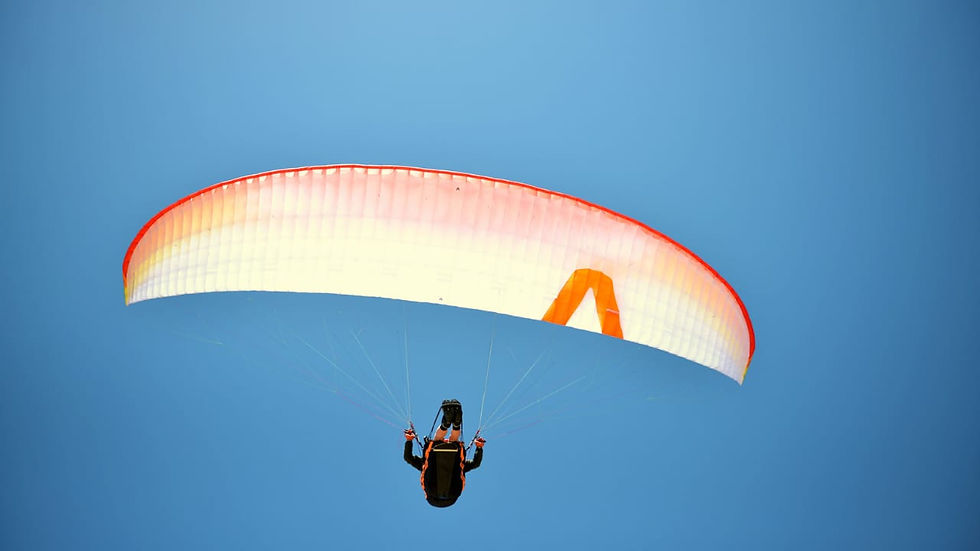Mastering Paraglider Landings: Choosing the Right Landing Spot and Avoiding Overshooting
- Kishan Katwal

- Oct 30, 2023
- 3 min read

Introduction: When it comes to paragliding, landing safely is a crucial skill to master. However, there are times when pilots overshoot their landing field, leading to potentially dangerous situations. In this article, we will explore how to choose a good landing spot, navigate sloping fields, and avoid the common mistake of overshooting. By following these tips, you can enhance your safety and ensure a smooth landing every time. Important Points: - Understanding the impact of lift and how it can cause overshooting - The importance of wind direction and aligning your landing field - Avoiding the S-turn error and utilizing loop turns - Using the butterfly landing approach to reduce altitude - Mastering spot landings, crosswind landings, and the butterfly approach - The significance of practice and continuous improvement Choosing a Good Landing Spot:
To avoid overshooting your landing field, it is essential to select a suitable spot. Consider the following key factors: - Wind direction: Understanding the wind patterns in your area is crucial. Ideally, choose a landing field that aligns with the wind direction, as this will provide better control during landing.
- Terrain hazards: Look for a landing spot that is free of obstacles such as trees, fences, or other hazards. The fewer distractions you have, the smoother your landing will be.
- Uphill landing: Whenever possible, aim for a landing field that slopes uphill. Sloping downward fields generate lift, making it challenging to land safely. Avoiding the S-Turn Error:
The S-turn error is a common mistake that pilots make, causing them to use up the entire landing field and overshoot. Here's how to avoid it:
- Loop turns: Instead of making S-turns, focus on making loop turns. When approaching your landing field, place your turns on the outer edges, allowing you to maintain proximity to the landing spot consistently.
- Resisting momentum: It's essential not to let the momentum of the glider drive you down the valley. Fight the urge to move further away from the landing field and maintain a direct line of approach. Utilizing the Butterfly Landing Approach:
When you find yourself with excess altitude and need to reduce it, the butterfly landing approach can be a useful technique:
- Swinging out to the left: If you have too much height, swing out to the left before coming back in on an upslope. This method helps dissipate altitude and sets you up for a safer landing.
- Butterfly approach: In certain situations, especially when you have a little surge and slow speed, you can opt for the butterfly approach. This approach involves flaring the glider slightly and bringing it down gradually while keeping it straight.
Mastering Spot Landings, Crosswind Landings, and the Butterfly Approach:
To enhance your landing skills and increase your success rate, focus on mastering spot landings, crosswind landings, and the butterfly approach:
- Spot landings: Practice landing at specific targets within your landing field. This exercise helps improve your precision and control during the landing phase.
- Crosswind landings: Develop proficiency in landing safely when the wind is coming from a different direction than your landing field. This skill is essential for various weather conditions.
- The butterfly approach: Make the butterfly landing approach a part of your training routine. This technique allows you to efficiently dissipate altitude and maintain stability during landing.
Summary: Mastering paraglider landings requires careful consideration during the approach and execution phase. By choosing a suitable landing spot aligned with the wind direction, avoiding the S-turn error, and utilizing techniques like loop turns and butterfly approaches, you can reduce the chances of overshooting your landing field.
Practice spot landings, crosswind landings, and the butterfly approach to further enhance your skills and ensure safe landings every time you take to the skies. Remember, continuous learning and improvement are the keys to becoming a proficient paraglider pilot. So, stay vigilant, practice diligently, and always prioritize your safety.





Comments